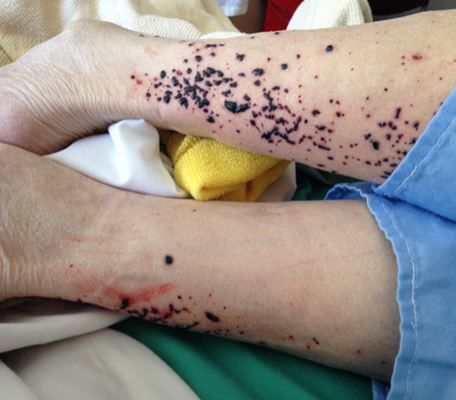- Clinical Technology
- Adult Immunization
- Hepatology
- Pediatric Immunization
- Screening
- Psychiatry
- Allergy
- Women's Health
- Cardiology
- Pediatrics
- Dermatology
- Endocrinology
- Pain Management
- Gastroenterology
- Infectious Disease
- Obesity Medicine
- Rheumatology
- Nephrology
- Neurology
- Pulmonology
Enoxaparin Dermatosis
This is a very distinct, rare, and remarkable hemorrhagic rash, first recognized in 2006, with 7 known cases reported in the literature.
Figure 1. Bilateral eruption of hemorrhagic, vesicular rash on patient’s calves.

Figure 2. Shave biopsy histopathology showing noninflammatory subepidermal bullae.

A 68-year-old woman with a history of chronic obstructive pulmonary disease, hypertension, and atrial fibrillation presented with a new embolic stroke. History revealed that she had been nonadherent to her anticoagulation therapy (rivaroxaban). Anticoagulation was initiated with warfarin. She was being bridged with enoxaparin subcutaneous injections in the upper extremities.
Four days after she began enoxaparin, a tender, firm, hemorrhagic vesicular rash, ranging from 0.1 to 0.8 cm, developed on her calves bilaterally (Figure 1). The rash bled with minimal trauma and dried into crusted scabs. These lesions were distant from the enoxaparin injection sites on her upper arms.
Laboratory results included: hemoglobin, normal; leukocytes, 19×109/L; platelets, 353,000/µL; prothrombin time, 21.8; INR 1.8.
Differential diagnoses considered were leukocytoclastic vasculitis, warfarin-induced necrosis, bedbug bites, enoxaparin dermatosis.
A shave biopsy specimen was obtained for histopathologic examination. It showed noninflammatory subepidermal bullae consistent with bullous hemorrhagic dermatosis (Figure 2). There was no evidence of leukocytoclastic vasculitis. No thrombosis was seen as might have been evident in warfarin-induced necrosis. This is consistent with enoxaparin dermatosis.
This is a very distinct, rare, and remarkable hemorrhagic rash, first recognized in 2006. It is crucial to diagnose it correctly because it may require cessation of culprit heparin or heparin derivative, especially if the rash is worsening. Notable is the fact that the rash does not occur at the site of injection but rather at sites distant from heparin use.
The exact cause is unknown. Existing case reports describe a self-limited course that resolves within several weeks without interruption of treatment or other adverse events.
References:
Naveen KN, Rai V. Bulloushemorrhagicdermatosis: a case report.Indian J Dermatol. 2014;59:423.
Peña ZG, Suszko JW, Morrison LH. Hemorrhagicbullae in a 73-year-old man. Bullous hemorrhagic dermatosis related to enoxaparin use. JAMA Dermatol. 2013;149:871-872.
Perrinaud A, Jacobi D, Machet MC, et al. Bullous hemorrhagic dermatosis occurring at sites distant from subcutaneous injections of heparin: three cases.J Am Acad Dermatol. 2006;54(2 suppl):S5-S7.
Villanuevaa CA, Nájerab L, Espinosaa P, Borbujoa J. Bullous hemorrhagic dermatosis at distant sites: a report of 2 new cases due to enoxaparin injection and a review of the literature. Actas Dermosifiliogr. 2012;103:816-819. doi:10.1016/j.adengl.2011.06.004
